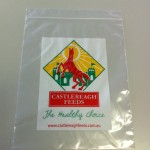 While some plastic bags can be reclosed, others can actually be resealed. Most of us are familiar with plastic resalable bags for sandwiches and freezer storage, but how much do you know about plastic resealable bags?
While some plastic bags can be reclosed, others can actually be resealed. Most of us are familiar with plastic resalable bags for sandwiches and freezer storage, but how much do you know about plastic resealable bags?
History
The history of resealable plastic bags began in 1954. That’s the year that a man named Robert Vergobbi received a patent for a plastic bag with a zipper. The company Minigrip would later license Vergobbi’s concept as pencil bags. Within time, people realized that resealable plastic bags could not only store items, but also keep food fresh. In 1957, a fifth grader named Robert LeJeune won the USA’s National Science Fair, by demonstrating this concept. A decade later in 1968, the company Glad and Dow Chemical launched its Ziploc brand, which has remained popular until today. Within time, several other manufacturers of plastic bags began producing resealable plastic bags themselves.
Types:
If you need a resealable plastic bag, then you’ll likely be (pleasantly) surprised by the various types that are available. Here are some of the main attributes of such plastic bags:
Grip: This type of resealable plastic bag includes a grip located along the bag’s top. Bags with such grips are extremely easy to open and close, making them quite convenient. People often use it for storing items such as leftover food. They’re often common in the medical industry, and are ideal for storing items such as cotton or gauze.
Seal: The method of sealing resealable plastic bags can differ. One of the most common types is the zipper style, which is common for sandwich bags and freezer bags. The latest innovations in the world of sealable plastic bags include a color-coding “system” that causes the individual yellow and green top edges of the bag to become green, after interlocking them. This is a fantastic way to ensure that the contents of the plastic bags are fresh and safe. You can quickly spot whether or not the bag is sealed completely. While the zipper seal is one of the most common variety, other types on plastic sealable bags include those with flaps.
The sealed plastic bag is another type, and contains glue that allows a user to seal and reseal the bag multiple times. One of the most common functions of sealed resealable plastic bags is for storing CDs and letters. It’s quite secure, which makes it a very popular option.
Thickness: The thickness of a bag is important based on factors such as the structure of the items that you’re storing, the temperature that you’re storing the items at, and how long you want the plastic bags to last. Resealable plastic bags are available in a wide array of thicknesses, so this is definitely a key issue to consider. For instance, choosing a thin bag could result in its contents becoming damaged.
Sizes:
Like other types of plastic bags, resealable plastic bags are available in a wide array of sizes. So when choosing a particular size, it’s crucial to consider factors such as the number of items that you’ll be storing, the size of the items that you’ll be storing, and so on. As when choosing other types of storage products, it’s always better to provide for some extra space to give you the option to add items to the bag later.
Materials:
Like non-resealable plastic bags, resealable plastic bags are made from different grades of plastic. The cost of such bags will greatly depend on the quality of the plastic used to produce them. So should you always choose a cheaper bag over a pricier one? That’s a viable option if you’re mainly concerned about the cost-effectiveness of the bag. But if you’re mainly concerned about safeguarding the items that you’re storing, then you should choose a bag made from a higher grade of plastic.
Uses:
There are tons of uses of resealable plastic bags. One of the most common ones is to store items such as sandwiches or frozen foods. The main benefits of such bags including ensuring you that the bags are air-tight, thus safeguarding the food inside them. Another common use of resealable plastic bags is for medical supplies. However, such bags are ideal for anything that needs to be extremely accessible, or stored in an airtight container.